
We have all experienced that tired feeling in our legs after a long day of work. If your job entails standing for long hours at a time, you’ll find that your feet and legs bear the brunt of discomfort. Wearing support stockings can prevent these feelings of exhaustion and can also help to prevent serious medical conditions from developing.

Support stockings are worn to improve blood flow, which prevents swelling and pain in the legs. They can also lower your chances of developing DVT (deep vein thrombosis), a condition caused by blood clots. If you have a medical condition related to circulation, compression garments will likely be prescribed by your doctor.
Compression stockings are made with a variety of purposes in mind. They come in all sizes, compression strengths and are suitable for men or women. You can purchase compression stockings with a mild or moderate pressure rating over the counter.
If you have been diagnosed with a medical condition, ComproGear suggests asking your doctor if compression socks are right for you, as some medical conditions can respond poorly to pressure therapy.
In this article, we’ll take you on a journey in which you will discover everything you need to know about support hosiery. We will also explore the benefits these stockings offer and how to avoid choosing the wrong compression stockings.
What Are Support Socks?
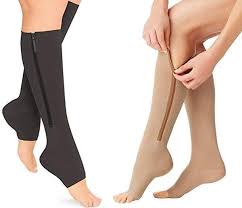
Support hosiery are stockings that have been designed for use in compression therapy. They are manufactured to apply gentle pressure to your ankles and legs, thus promoting blood flow from your feet all the way up to your heart.

Compression stockings are made to fit snugly against your legs and give them a bit of a squeeze. Often you’ll find graduated compression stockings that are designed to be tighter at the ankle and progressively looser as they move up your leg.
You can purchase most types of compression stockings over the counter at your local pharmacy or online at ComproGear. But if you have a serious medical condition, then you will need to get a prescription from your health care provider.
Who Uses Support Stockings?
Many people use compression stockings on a daily basis for both medical and non-medical purposes. Medical professionals also prescribe compression therapy for both mild and serious diagnoses. Here are examples of the types of people who may benefit from pressure hosiery:
- Athletes.
- Pregnant women.
- Those who have just had surgery.
- People who stand all day at work.
- People spending long periods traveling.
- People with circulation problems like varicose veins, DVT or diabetes.
- Those that can’t leave their bed or have a hard time moving their legs.
What Does Compression Hosiery Do?

Compression stockings put pressure on your legs to help your blood vessels work more efficiently. The gentle squeeze of your compression socks will allow your muscles to relax while compressing the walls of your veins, boosting the blood back towards your heart.
Compression hose can also keep your legs from getting tired and ease any swelling in your feet. They are used to treat varicose veins or to prevent varicose veins from reforming after sclerotherapy. If you have been diagnosed with orthostatic hypotension, compression therapy can stop you from feeling light-headed or dizzy when standing up.
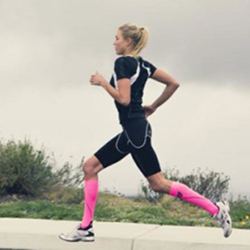
Some athletes use compression sleeves on their arms and legs to improve their performance. Though it has not yet been proven that performance can be improved with compression socks, pressure stockings do help improve blood circulation.
In theory, the compression socks create better blood flow during activities, helping the athlete get oxygen to their muscles more efficiently. When worn after a workout, this can speed the recovery of damaged tissues or injured muscles.
Different Types of Compression Hosiery
There are three main types of compression stockings:
- Non-medical support stockings.
- Graduated support hose.
- Anti-embolism hosiery.
You can also choose from a couple of styles of compression socks. Stockings which end just below the knee help limit lower leg swelling or peripheral edema due to fluid buildup. Stockings which extend to the thigh help in reducing pooling of blood in the legs, thus preventing orthostatic hypotension.

Non-Medical Support Stockings
Non-medical support stockings do not typically require a prescription. These stockings include elastic support hosiery and flight stockings which are worn to prevent aching and tired legs. Non-medical pressure stockings deliver uniform compression and exert less pressure than prescription support hosiery. These stockings can be purchased at ComproGear or your local pharmacy.

Thromboembolic Deterrent (TED) Hose
Thromboembolic deterrent hose, also called anti-embolism stockings or TED hose, are used to reduce the risk of deep vein thrombosis (DVT). They offer graduated compression at a level of pressure designed specifically for immobile patients.
Graduated Compression Stockings
Graduated compression stockings offer compression that is strongest at the ankle and decreases gradually up your leg. They are designed with mobility in mind; they will not slide down the leg if you are running or walking. These stockings typically require professional fitting.
Related Articles on ComproGear.com
Socks for Gout and Easy To Put On Compression Socks For Elderly
Using Compression Stockings

Here are some helpful tips to keep in mind as you put your compression socks on:
-Compression stockings should be put on first thing in the morning before swelling can occur. If you wait until after walking about, it may be more difficult to put on the hosiery.
-Since support stockings fit tightly, you may need to apply talc powder or cornstarch to your ankles and legs to help ease the socks on.
-Do not apply lotion to your skin before attempting to wear your compression hose. Extra moisture on the skin can make it difficult to pull your socks on. It is best to moisturize your skin the night before to ensure the lotion is well absorbed by the time you put your socks on in the morning.
-To put on support socks, roll down the socks from the top down to the heel. Slip just your toes into the stocking and slowly unroll the stocking up your leg. This is the easiest way to ensure a neat fit.

-Take your stockings off before taking a shower.
-For the best results, wear your support socks throughout the day and remove them before jumping into bed.
-Hand wash your pressure stockings in cool water with a mild soap. Gently squeeze out the excess water without wringing or twisting the socks then hang them out to dry over night.
-It’s a good idea to have at least two pairs of compression stockings on hand so when one is being washed and dried, you can wear the other pair. This will enable you to follow through with your compression therapy without skipping a day.
How to Choose the Right Support Hosiery

There are many types of compression stockings available and they differ in size, material, style and compression strength. With so many options, it can feel overwhelming to find the compression garment that is best for you.
Below are the key factors you need to consider before settling on a pair of compression stockings. If you are in need of compression stockings because of a medical condition, your doctor is the best resource you have.
Compression Strength
The pressure strength of your compression socks will depend on your needs. Take a look at the following pressure levels and see which one is recommended for your health and wellness goals:

- Light to Moderate, 15-20 mmHg – Support socks within this pressure level are wonderful for traveling. They will come in handy as they improve blood circulation, even when you sit for long periods of time during travel. Pregnant women, anyone experiencing mild leg swelling and workers who must stand all day can benefit from 15-20 mmHg compression strength.
- Moderate Compression, 20-30 mmHg – Moderate compression is a wonderful option for those experiencing moderate swelling or who have varicose veins. These can be worn to prevent your legs from becoming heavy and tired. Support stockings with 20-30 mmHg are a top-selling pressure level.
- Firm Compression, 30-40 mmHg – For those who have severe varicose veins, moderate edema or who have undergone vein treatment, a firm compression level is the best option.
- Extra-Firm Compression, 40-50 mmHg – These support hosiery come in handy for managing severe edema, chronic venous diseases, varicose veins or severe post-thrombotic syndrome. Extra-firm compression strength stockings require a doctor’s prescription.
- Heavy Compression, 50-60 mmHg – The strongest compression level, support stockings with 50-60 mmHg will need a prescription from a healthcare provider. They are primarily used for relieving post-thrombotic syndrome and lymphedema.
Style

You should consider a sock style which will complement your attire and fit in with your lifestyle. Retailers offer various options from plain colors to patterns, open-toe or closed-toe compression hose, knee-high or thigh-high socks and specialized fabrics. Your desired use and sense of style will play a big part in guiding your decision when choosing a support stocking.
Material
Support socks can be made from different materials depending on the use of the support hose. Lycra, spandex or cotton combinations are common. ComproGear compression socks are made of a mix of elastane and Lycra to provide durability, moderate pressure and a breathable material for comfort.
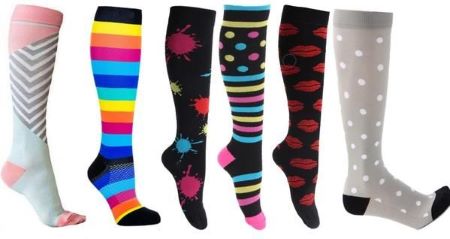
Sizing
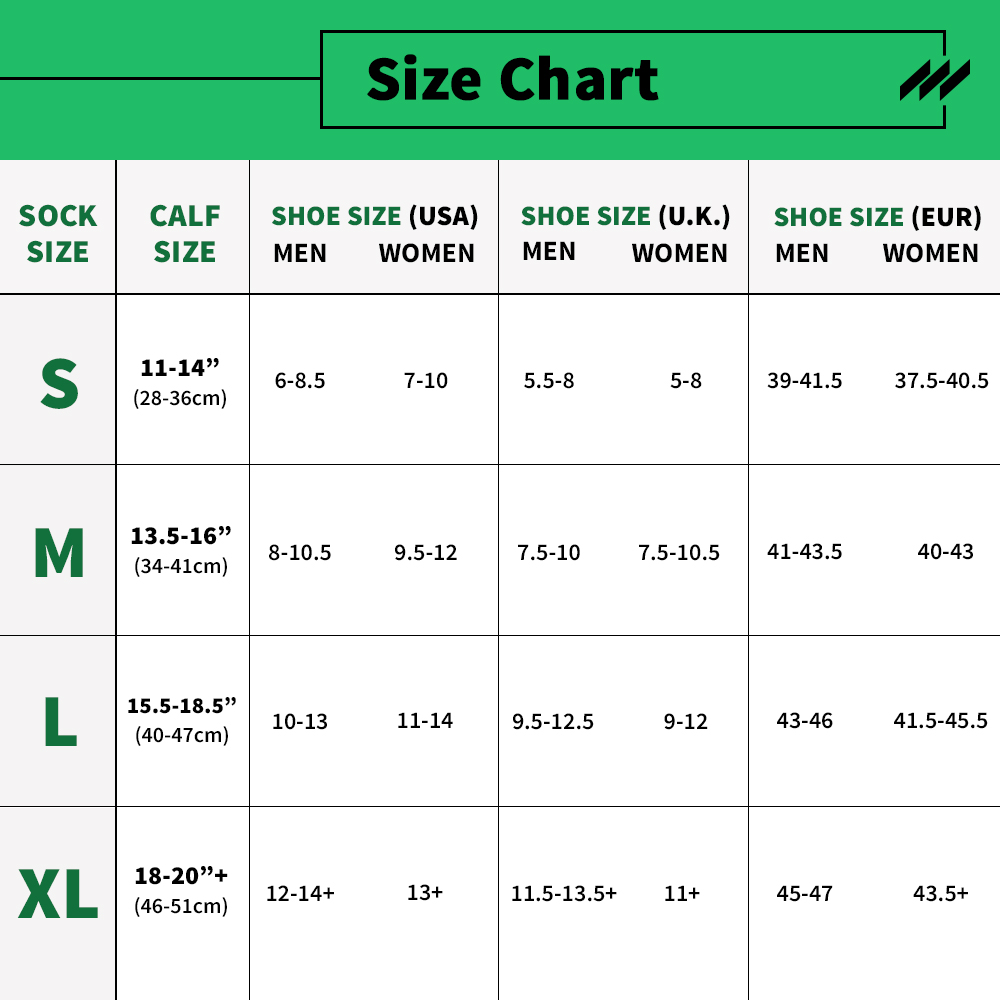
When selecting your compression hosiery, choosing the right size is one of the most important factors. Retailers will provide a measurement chart which will instruct you on how to best determine your size.
The wrong fit can cause painful, unpleasant symptoms or render your pressure stockings ineffective all together. ComproGear’s knee-high sock sizing chart (image to the right) shows how calf size and shoe size are used to determine your size of compression sock.
When preparing to purchase thigh-high or full-length pantyhose compression stockings, you will need to know your height as well as the measurement for the circumference of the widest part of your thigh.
What Are the Benefits of Support Hosiery?

With such a wide range of benefits to wearing compression hosiery, you’ll be able to find a reason that suits your needs:
Pressure Socks Promote Comfort
Joint pain and fluid buildup can cause discomfort in the legs. Using compression stockings will result in better circulation and improve your comfort throughout the day.
Better Blood Circulation
Support socks help in improving blood circulation by applying pressure on your foot, preventing blood from pooling and avoiding blood clots. Better blood flow also results in an overall healthier body. If you are still unsure about the compression level that best suits your needs, check in with your health care provider.
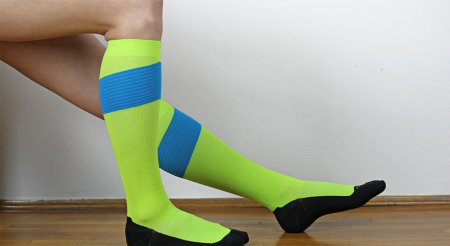
Treat Varicose Veins
Compression stockings are recommended as a way to prevent and manage varicose veins. Varicose veins are a condition where veins become swollen and raised, pushing out against the skin.
Wearing compression socks allows for gentle pressure to be applied to the veins, maintaining regular blood circulation. ComproGear suggests choosing a compression strength between 15-20 mmHg in order to help relieve the aches and pains related to varicose veins.

Prevent Fatigue
The right compression strength will improve your energy levels as a result of improved circulation. Choosing the appropriate pressure level can help you avoid fatigue after a long day at work.
Prevent Edema
Wearing compression stockings can help you avoid swelling and fluid buildup in the feet and legs.
What Happens if I Choose the Wrong Compression Strength?

It is always important to have all the facts before purchasing compression hosiery. There can be side effects when you choose the wrong compression strength for your stockings, which can worsen your condition.
If you have a medical diagnosis, the best approach is to get your support stockings fitted by your healthcare provider. Wearing the wrong pressure rating can have several side effects:
- Itching.
- Joint pain.
- Discomfort.
- Loss of circulation.
- Tingling in the feet.
- Corns and calluses.
In Conclusion
There are different levels of compression available and choosing the correct pressure strength is important to your health. If you are in doubt about which compression level best suits you, contact your doctor for a fitting. We suggest copying medical professionals and using the best compression socks for nurses.
If you already understand your needs and do not have a serious medical diagnosis, you can purchase over-the-counter support stockings. Most retailers will provide a fitting chart which you can use to determine your size to avoid the consequences of wearing the wrong compression strength.
Support stockings apply pressure to your ankles and legs, improving blood circulation from your lower legs to your heart. For those who have a serious medical condition, your first stop before getting your compression stockings will be your health care provider.
This page last updated October 25, 2022
